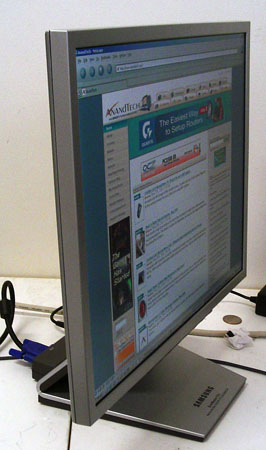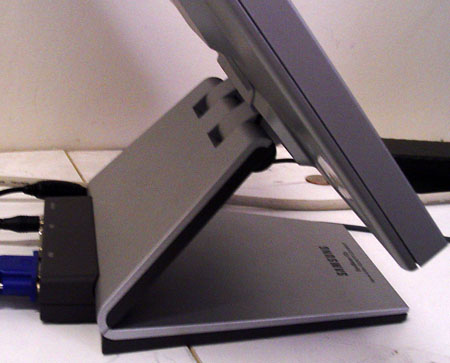Samsung 172X: 12ms Response Time for 17" LCD
by Kristopher Kubicki on June 8, 2004 12:05 AM EST- Posted in
- Displays
Construction
Most Samsung LCDs that we have seen in the past two years are radically different in design than anything else currently available. We expected the SyncMaster 172X to look like nothing else available right now.| Samsung SyncMaster 172X | |
| LCD | 17" SXGA LCD (Active Matrix) pixel pitch: 0.264mm Anti-glare coating TN Display Mode |
| Scanning Frequency | Horizontal: 30-80kHz Vertical: 56-75Hz |
| Response Time | 12ms (Typical) |
| Contrast Ratio | 500:1 (Typical) |
| Compatibility | 1280 x 1024 (Native) |
| Brightness | 270 cd/m2 |
| Power | Working: 40W Standby/Off: 5W |
| Warranty | 3 years parts and labor |
Unlike the Sharp LL-191A-B unit that we looked at last month, the Samsung 172X sports an even lower average response time - 12ms. Don't forget to check out our comments on response time in that publication. Unfortunately, the display uses a method of Frame Relay Control (FRC) on a TN mode display. Over the last few years, Samsung has relied almost exclusively on its own PVA (Pattern Vertical Alignment) display mode (a little bit more info is here). Going from PVA to TN display modes is a fairly big deal for Samsung; PVA is typically regarded as a much more elegant and efficient display mode. TN displays typically have shallower viewing angles and do not appear as crisp.
Specifications are fairly on par with what we have seen concerning other 17" LCDs from Samsung. Our 172X is slightly brighter than last year's SyncMaster 172T model; 270 nits versus 250. While correct, we could increase the brightness to surpass the luminance of some of our other 250 nit LCDs, and color washes out very quickly. This is tell-tale of the 6-bit LCD panel (we saw similar results on our LL-191A and Hitachi CML174).
Like many of our LCDs of late, the Samsung 172X had zero pixel defects. We did not find a single stuck pixel or subpixel.












19 Comments
View All Comments
Crosster - Monday, June 21, 2004 - link
Just another test :http://www.xbitlabs.com/articles/other/display/sam...
Crosster - Monday, June 21, 2004 - link
nourdmrolNMT1 - Sunday, June 13, 2004 - link
question: what is the difference in this LCD screen, and the MUCH cheaper 12ms response 710N or 710T (t just has the DVI input)?MIKE
MadAd - Saturday, June 12, 2004 - link
Ho well, just another 6 bit panel, big whoop.When o when are we going to start seeing competition at the 19" 32bit 1280x1024 16ms $550 (£300) level?
When I bought this 17" Iiyama e431s i thought it was only going to be a season or 2 and ill be able to upgrade to something bigger, faster, stronger but now whats all this 6 bit retrograde stuff? Man they are dragging their heels here.
skunkbuster - Wednesday, June 9, 2004 - link
as soon as they make an lcd with true 32bit coloring(and not that dithering crap) with 16ms times or lower, i'll get one.i dont like the fact that they have to sacrifice color reproduction for low response time. grrr
TheAudit - Wednesday, June 9, 2004 - link
#11 – What about if you are space constrained and don’t want a 50 lb behemoth with a two foot long neck on your desk?#13 – You are correct. CRT technology hasn’t moved in years.
JGF - Wednesday, June 9, 2004 - link
11, I wouldnt call the move to LCDs a 'fad'. Its the sound of inevitability. :) CRT's are dead. It pains me to say it since LCDs dont best meet my needs but CRT manufacturers are drastically cutting their lines back or dropping them all together and refocusing on lcd monitors.Crosster - Wednesday, June 9, 2004 - link
I own one of this baby since 3 weeks, i'm very pleased with it. Display is very reactive (I play RTCW) and the only negative point I see is some dither in black colors, especially in video or DVD viewing.If you buy this screen, you should be aware of dead pixels (i had to test 5 different screens to get a clean one (a lot of them where red lit)
Otherwhise, I know it's not relevant but i just want to see the result, is it possible to get the Color profile you created for this article?
PS : Can we get too the date of manufacturing and the origin of the screen? Thanks
IkeEisenhower - Wednesday, June 9, 2004 - link
This (and I really hate to have to use this term) corporate-hyped fixation on LCD and plasma displays is what turned me off of Tom's initially. I realize the site is all about chronicling the 'latest' technology, but Anandtech has always strived more to achieve end-user quality over faddish toys like these things. Unless you literally have money to burn or can't afford a decent desk or pay four bucks extra on your power bill, there is ablsolutely no advantage to using either an LCD or plasma display in favour of good 'ol perfected-technology CRTs. Sure, you can get a plasma to look decent at 1024x768 at forty diagonal inches, but unless you have a forty-inch-diameter head, it's useless. You can get the absolute best commercially-available 21-inch CRTs for easily half the price of a 22" LCD with decent tech in it. But althogh you can carry your new LCD in one hand, your colours suck, ghosting is inevitable, contrast levels fluctuate from bad to worse, AND YOU'RE SPENDING MANY THOUSANDS OF DOLLARS for something that merely looks cool. I know that the top CRTs out there have been done to death review-wise by innumerable other sites, but it would be great to see Anandtech buck the trend and show you spec-for-spec how 'good' these new LCDs are compared to CRTs that do everything so well they don't really have any room for improvement (the infamous Sony quip), and bottom-line the price.My two cents, for what it's worth.
ElFenix - Wednesday, June 9, 2004 - link
yet another low resolution desktop LCD. I seriously do not understand why laptop LCDs have significantly higher DPI. mine runs at 142 DPI. in contrast a 17" 1280x1024 resolution monitor such as this runs at about 97 DPI. a 17" version of a typical notebook screen would run something about 1900 pixels across the screen, so obviously manufacturers don't have a problem with the DPI of making a 1600x1200 17" LCD, and yet they don't. i guess i just don't get it. why wouldn't people want 50% more desktop area?